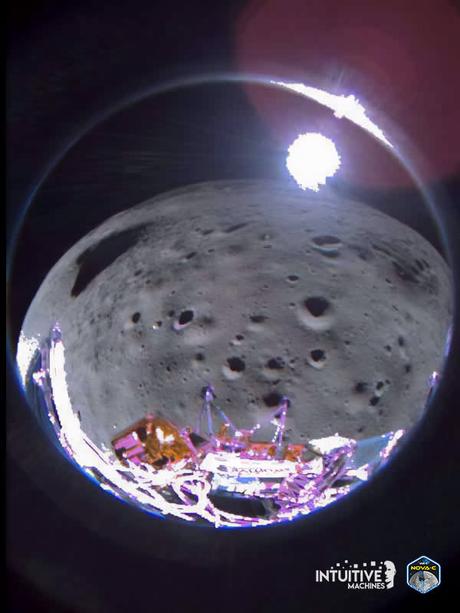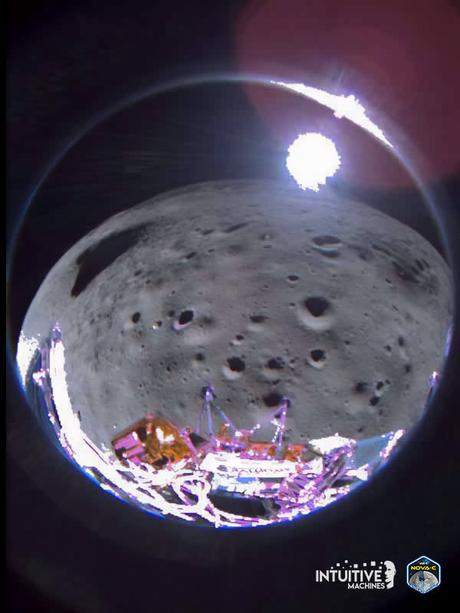It's been four days since the first private moon landing, an event shrouded in all kinds of emotions. We'll go into that in a moment. First of all, a few hours ago we got brand new footage of this achievement, as well as a sad but inevitable update on the fate of the lander.
For a brief explanation, on February 26, Intuitive machines announced on X (formerly Twitter) that Odysseus is still communicating with ground control despite falling gently on his side after a while shaky moon landing. Better yet, Odysseus managed one few images of the moon. One was captured as it approached its landing site, called Malapert A, and the other appears to be the first close-up angle we've seen of the moon's surface.
It also appears that NASA's Lunar Exploration Orbiterthat is scanning the moon from lunar orbit since 2009, caught sight of Odysseus (as it has done with many a lunar lander before) from an altitude of about 90 km. He dutifully beamed back his bird's eye view Soil. "Images of NASA 's Lunar Reconnaissance Orbiter Camera team confirmed that Odysseus completed its landing at 80.13°S and 1.44°E at an altitude of 2579 m," Intuitive Machines explained in the X-post. 'After traveling more than 600,000 miles, Odysseus landed within a mile of his intended Malapert A landing site, using a contingent laser range-finding system patched hours before landing.
Related: Intuitive Machines' Odysseus lander tipped over on the moon during 'spicy' moon landing


In addition to this lunar gallery, however, mission controllers also offered a more practical update on the mission. "Based on the positioning of the Earth and moon, we believe flight controllers will continue to communicate with Odysseus until Tuesday morning," the team said in a statement on the company website.
If you're a little dismayed by the quality of Odysseus's images (not LRO's, which are always surprisingly high resolution), you can blame the complicated, almost twisty landing situation the lander had to endure on February 22.
The tragedy
When the geometric Odysseus spacecraft arrived on the moon's surface, its achievement was not immediately greeted with cheers. The team was perplexed.
It was because the lander didn't initially call home; even the company's public broadcast of the event was noted with radio silence, nervous laughter and hesitations. The estimated landing time had passed, but where was the concrete evidence that Odysseus had not crashed? Furthermore, tensions were heightened by a dramatic situation that had occurred just a few hours earlier; Odysseus' laser rangefinders, meant to tell the spacecraft where it is and how fast it is going, stopped working. Engineers had to scramble to solve the problem, as the problem occurred several hours before the landing window opened - a window that was ultimately postponed due to the accident.
Brilliantly, the team found a way to reuse one of Odysseus' twelve loads known as the Navigation Doppler Lidar for Precise Velocity and Range Sensing to act as the mission's new compass. With a bit of luck, the NDL had its own laser software that could serve as a replacement GPS.
But even when Odysseus finally sent back a communication signal, the signal was extremely weak.
Ultimately, after investigating what was going on with the spacecraft, scientists were able to confirm that Odysseus was alive and well on the moon. However, they also realized that somewhere along the way to landing, Odysseus accidentally fell over during his journey and landed on his side. According to Intuitive Machines, this view of the landing, captured by a camera on the starboard side of the lander, was taken about 35 seconds after Odysseus was taken over before landing.


Not all was lost, as the team said there was scientific research on board that could still be used. According to the February 26 on the moon."
Odysseus also seems to have grown a bit stronger over time compared to his original delicate communication signal. Yet an important imaging component of the mission experienced a setback.
Originally, a camera called EagleCam was to be deployed when Odysseus landed, capturing some spectacular images of the entire sequence. Still, "the decision was made to turn off EagleCam during landing and not deploy the device during Odysseus' final descent," said Mike Cavaliere, director of news and media relations at Embry Riddle Aeronautical University. wrote in an update on February 23. That's the university behind EagleCam's design. However, Cavaliere assured that EagleCam would be called in for a photo shoot at a later date.
According to Intuitive Machines' latest update, the team has also confirmed that Odysseus "represents the southernmost portion that has been able to land a vehicle on the moon and establish communications with ground controllers." This is a big problem because room Agencies have been working lately to reach the moon's south pole, including that of the Indian Space Research Organization Chandrayaan-3 and the (failed) Russian Luna-25 effort.
Related stories:
- This is what just landed on the moon aboard Intuitive Machines' Odysseus lander
- Intuitive Machines lands on the moon in nail-biting descent of private Odysseus lander, a first for the US since 1972
- Intuitive Machines' Odysseus lunar lander did not deploy camera during historic descent
And in the end, even with the hiccups, Odysseus is a lander that will certainly go down in history. It is the first private spacecraft to reach the lunar surface and the first successful proof-of-principle for NASA's Commercial Lunar Payload Services program, intended to revolutionize the way we access the moon in the future see it happen. Unfortunately, we will have to say goodbye soon.
"Flight controllers plan to collect data until the lander's solar panels are no longer exposed to light," Intuitive Machines said in the X-post. Without sunlight, Odysseus will have to endure the frigid moon night - a night that most of our robotic explorers will not survive.
